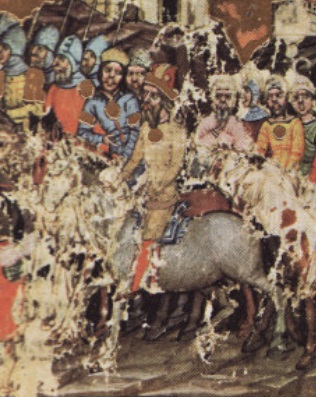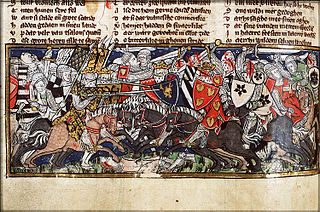Related Research Articles

The Huns were a nomadic people who lived in Central Asia, the Caucasus, and Eastern Europe between the 4th and 6th centuries AD. According to European tradition, they were first reported living east of the Volga River, in an area that was part of Scythia at the time. By 370 AD, the Huns had arrived on the Volga, causing the westwards movement of Goths and Alans. By 430, they had established a vast, but short-lived, empire on the Danubian frontier of the Roman empire in Europe. Either under Hunnic hegemony, or fleeing from it, several central and eastern European peoples established kingdoms in the region, including not only Goths and Alans, but also Vandals, Gepids, Heruli, Suebians and Rugians.
Dengizich, was a Hunnic ruler and son of Attila. After Attila's death in 453 AD, his empire crumbled and its remains were ruled by his three sons, Ellac, Dengizich and Ernak. He succeeded his older brother Ellac in 454 AD, and probably ruled simultaneously over the Huns in dual kingship with his brother Ernak, but separate divisions in separate lands.
Charaton was one of the first kings of the Huns.

Uldin, also spelled Huldin is the first ruler of the Huns whose historicity is undisputed.

Otto John Maenchen-Helfen was an Austrian academic, sinologist, historian, author, and traveler.
By the name Edeko are considered three contemporaneous historical figures, whom many scholars identify as one:

Balamber was ostensibly a chieftain of the Huns, mentioned by Jordanes in his Getica. Jordanes simply called him "king of the Huns" and writes the story of Balamber crushing the tribes of the Ostrogoths in the 370s; somewhere between 370 and more probably 376 AD.

Laudaricus was a prominent Hunnic chieftain and general active in the first half of the 5th century.
Basich or Basikh was a Hun military commander who co-led an invasion of Persia in 395 AD together with Kursich.
Kursich was a Hun general and royal family member. He led a Hunnish army in the Hunnic invasion of Persia in 395 AD.
Mamas was a Hun royal family member who was impaled by Attila in Thrace.
Chelchal was a Hun commander serving as lieutenant general under the Byzantine Empire.
Sigizan was a Hun general in the Byzantine army.
Zolban or Zolbon was a Hun general fighting for the Byzantine Empire. He fought alongside fellow Hun commander Sigizan against the Isaurians in 493 AD.
Tarrach was a Hun military officer for the East Roman Empire. He was the assassin of the officer Cyril. Tarrach was credited as the "fiercest of the Huns".
Turgun was a military officer of Hunnish descent of the Byzantine Empire.
Ultzindur was a Hun nobleman and a blood relative of Attila.
Gordas was a prince of the Crimean Huns.
Elmingir also Elminegeir, Elmingeir was a Hun general fighting for the Byzantine Empire.
Apsich or Aspik was a Hun military leader in the Byzantine Empire.
References
- ↑ Maenchen-Helfen, Otto J. "The World of the Huns. Chapter IX. Language". www.kroraina.com. Retrieved 27 October 2022.
- ↑ Agathias (2011). Frendo, Joseph D. C. (ed.). The Histories. De Gruyter. p. 34. ISBN 9783110826944 . Retrieved 27 October 2022.
- ↑ Maenchen-Helfen, Otto J. (2022). The World of the Huns Studies in Their History and Culture. University of California Press. p. 405. ISBN 9780520302617 . Retrieved 27 October 2022.